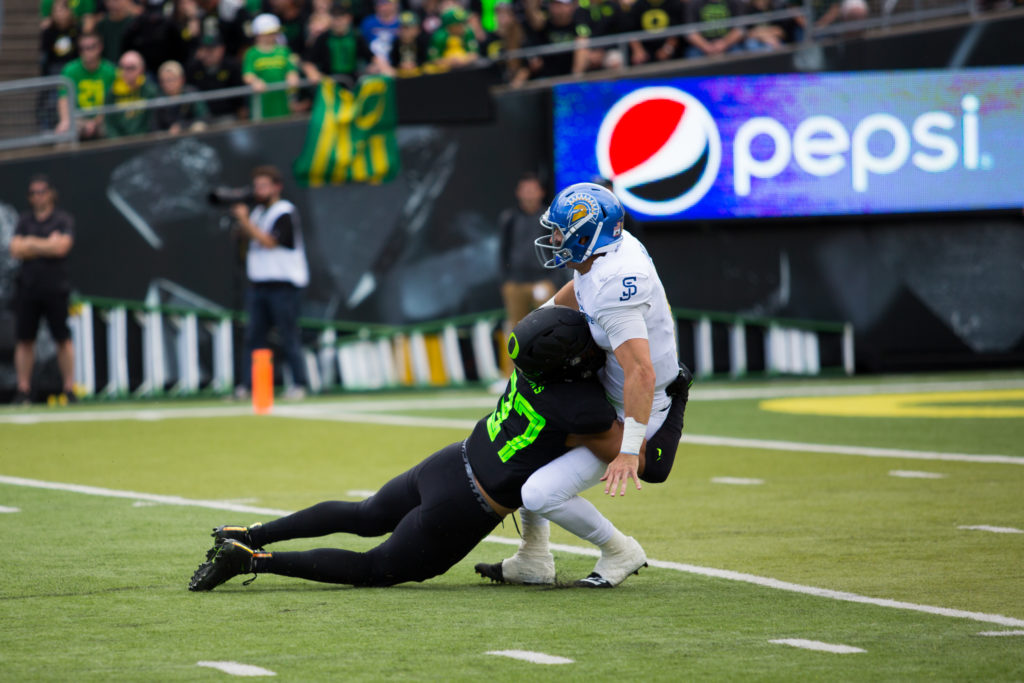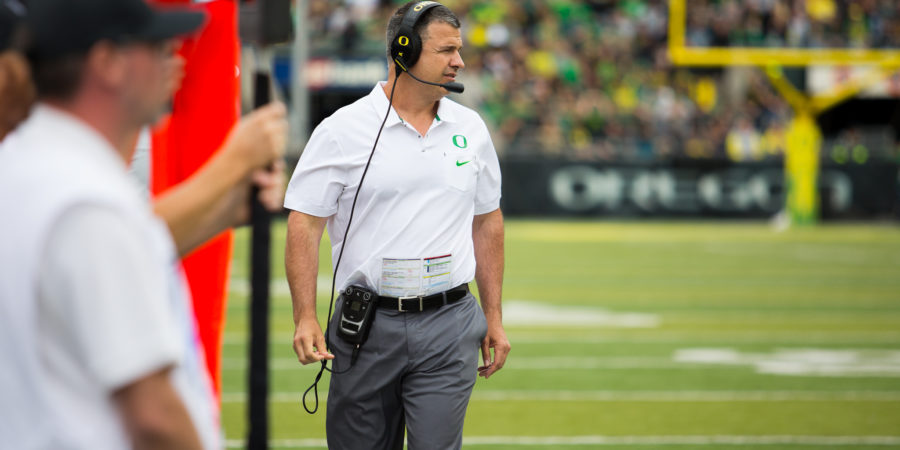Following a decidedly flat performance in their 35-22 victory over San Jose State last Saturday (the third and final game for the Ducks against Charmin soft non-conference competition this season), Oregon head coach Mario Cristobal was asked if he felt his team was ready to take on 7th-ranked Stanford this Saturday inside Autzen Stadium.
“I think it’s time to go find out,” said Cristobal.
Spending some time in thought, you realize the reply kind of perfectly encapsulates much of the “lol…idk” that surrounds this team despite the fact that we’re now officially a quarter of the way through the season.
Many of the questions that followed the Ducks during the offseason have gone unanswered, as wins over Bowling Green, Portland State, and San Jose State have shed little light on where this team actually stacks up in relation to other teams within the conference and across the country.
Offensively, we know what Oregon has in Justin Herbert, a quarterback who looks every bit the part of a future first round NFL draft pick. He’s also a player who, with a big game against Stanford on Saturday, could easily catapult himself to the forefront of the Heisman Trophy discussion.
However, with a running attack that noticeably lacks a marquee name and a marquee performance through three games, coupled with a wide receiver group that has been tormented by dropped balls and an inability to consistently find separation from defensive backs, the Oregon offense finds itself in unfamiliar and precarious territory with Pac-12 play set to begin.
On defense, the Ducks boast a formidable front seven that has performed up to preseason snuff. Names like Jalen Jelks, Troy Dye, Justin Hollins, and Jordon Scott are expectedly spearheading a group that currently ranks in the top 10 nationally in both sacks (tied for 6th with 11) and rushing yards allowed per game (9th with 77 yds/game), and in the top five in terms of rush yards allowed per attempt (5th with 1.96 yds/carry).
Yet, against the pass, the Oregon defense has proven to be far less productive, as the Ducks currently rank:
- 69th nationally in opponent QB rating (123.71)
- 78th nationally in passing yards allowed per game (226.0)
- T-88th in passing touchdowns surrendered (6)

Again though, the amount of reliable weight that any of these statistics and opinions hold is up for debate. Valid arguments can be made that skew these numbers and prevailing thoughts one way or the other based on the notion that the competition is weak, there’s a general malaise that naturally sets in as a result of playing weaker competition, or some unscientific combination of the two.
Then there’s the whole other question of whether this team is even emotionally prepared to handle the gravity that comes with the opportunity to host a top ten ranked team with significant conference and national title implications on the line. Oh, and did we mention that ESPN’s College GameDay is also coming to town, bringing with them the eyes of the college football world?
Collectively, Saturday’s game is a game of firsts for Oregon’s coaches and players. It’s a lot to process for a program that has undergone multiple leadership changes and has been far removed from college football’s national conscious since the last time the GameDay crew made its way to Eugene in 2014, when the Ducks hosted Michigan State. In fact, Jelks, Hollins, Tony Brooks-James, Mattrell McGraw, and Devin Melendez are the only current Ducks who were on the roster in 2014, and even then, only Hollins and Melendez, a long snapper, saw live game action for Oregon that season.
Even more, Saturday’s game versus the Cardinal will be first time since November 21, 2015 (No. 22 USC vs. No. 23 Oregon) that Autzen Stadium has hosted a game pitting two Top 25 ranked teams, as the Ducks endured a 4-8 season in 2016 and have sported an overall record of 15-15 since that day.
As much as Duck fans have been pining for a return to relevance, in many respects, the convergence of all these aforementioned questions and unquantifiable factors makes the hype around the game feel somewhat premature, though no less exciting. Anecdotally speaking, unlike years past, it doesn’t feel like the necessary and obvious incremental steps have been taken for Oregon to capitalize on such a statement opportunity. And philosophically, it doesn’t feel like the identity and spirit of this team has yet been fully-formed.
Perhaps that’s because it hasn’t. And perhaps this new era of Oregon football requires plugging your nose and cannonballing into the deep end of the pool to find out whether you sink or swim.
It’s here, in the midst of all the excitement, build-up, and uncertainty, where those eight little words from the mouth of Mario Cristobal wax poetic.
“I think it’s time to go find out.”

